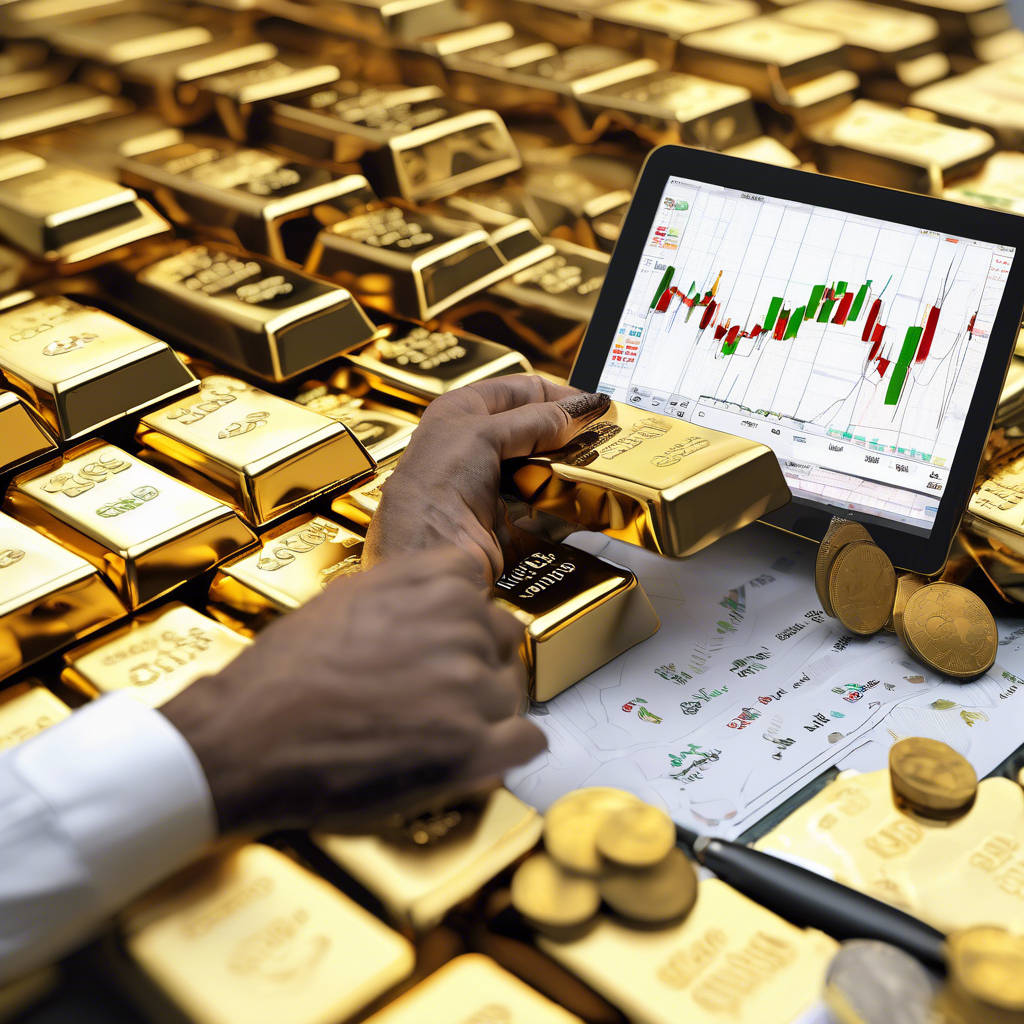Understanding the Importance of Gold Trading Techniques
When it comes to investing in gold, employing effective trading techniques is crucial for maximizing your returns. Gold trading is not just about buying and holding; it requires a strategic approach to navigate the complexities of the market. Whether you’re a beginner or a seasoned investor, knowing the right techniques can significantly enhance your investment performance.
1. Technical Analysis: Reading the Market Trends
One of the fundamental gold trading techniques is technical analysis. This involves analyzing price movements and market trends through charts and indicators. By understanding patterns, you can make informed decisions about when to buy or sell gold. Tools like moving averages and relative strength index (RSI) are instrumental in spotting potential market reversals and trends. Utilizing these tools can help you capitalize on price fluctuations and maximize your returns.
2. Fundamental Analysis: Understanding Market Drivers
In addition to technical analysis, fundamental analysis is essential for gold trading. This technique involves evaluating economic indicators, geopolitical events, and central bank policies that influence gold prices. For instance, understanding how inflation rates and currency values impact gold can provide insights into potential market movements. Staying informed about these factors can help you make educated trading decisions. For a deeper dive into the factors impacting gold prices, check out our article on Gold Price Forecast: Conditions Influencing Future Prices.
3. Diversification: Spreading Your Investments
Diversification is a key strategy in gold trading. Instead of putting all your capital into one type of gold investment, consider diversifying your portfolio. This might include a mix of physical gold, gold ETFs, and gold mining stocks. Each type of investment has its own risk and return profile. By spreading your investments, you can mitigate risks while enhancing your potential returns. For more insights into the types of gold investments worth considering, visit Types of Gold Investments That Are Worth Your Time in 2025.
4. Timing the Market: Strategic Entry and Exit Points
Timing is everything in gold trading. Knowing when to enter or exit a position can make a significant difference in your returns. Employing techniques like dollar-cost averaging can help you manage your investments more effectively. This strategy involves investing a fixed amount of money at regular intervals, regardless of the price of gold. This approach can reduce the impact of market volatility and lead to better long-term results. For expert tips on timing and strategies, read our post on Top 5 Gold Investment Strategies You Need to Implement.
5. Continuous Learning: Staying Ahead of the Curve
The gold market is continually evolving, making it essential for investors to stay updated on the latest trends and techniques. Engaging with educational resources and market analysis can provide valuable insights that help you refine your trading strategies. By continuously expanding your knowledge, you can adapt to market changes and optimize your investment returns.
In conclusion, mastering gold trading techniques is vital for boosting your investment returns. By combining technical and fundamental analysis, diversifying your portfolio, strategically timing your trades, and committing to continuous learning, you can position yourself for success in the gold market.
Developing a Robust Gold Investment Strategy
To truly excel in gold trading, developing a robust investment strategy is essential. This strategy should balance risk management with the potential for returns. Investors must consider various factors, including market conditions, personal investment goals, and risk tolerance. By crafting a well-thought-out plan, you can navigate the complexities of the gold market more effectively.
1. Understanding Risk Management in Gold Trading
Risk management is a cornerstone of successful trading in gold. This involves setting clear stop-loss orders to limit potential losses and determining the right position size based on your overall portfolio. For instance, many investors opt to risk only a small percentage of their capital on a single trade, ensuring that a single loss won’t derail their overall strategy. To learn more about risk management techniques, explore our guide on Investing in Gold: Risks and Rewards Explained.
2. Leveraging Gold ETFs for Portfolio Diversification
Gold Exchange Traded Funds (ETFs) offer a flexible way to gain exposure to gold without the need to buy physical bullion. These funds track the price of gold and can be bought and sold on the stock exchange like regular stocks. Gold ETFs can provide liquidity and lower transaction costs compared to physical gold investments. If you’re considering ETFs, check out our detailed post on Gold ETFs: The Smart Investor’s Choice in 2025 for insights on the best options available.
3. The Role of Economic Indicators in Gold Trading Decisions
Economic indicators, such as inflation rates, employment statistics, and interest rates, play a crucial role in gold trading. These indicators can influence investor sentiment and the demand for gold as a safe-haven asset. For instance, during periods of economic uncertainty, gold often sees increased demand, driving prices higher. Staying informed about these economic indicators can help you anticipate market movements. Our article on How to Interpret Gold Demand Trends for Better Investments delves deeper into this aspect.
4. Utilizing Charts and Technical Indicators for Entry Points
Charts and technical indicators are invaluable tools for identifying entry and exit points in gold trading. Indicators such as Bollinger Bands, MACD, and Fibonacci retracements can help traders make informed decisions based on historical price movements. Learning to read these charts can give you a competitive edge in timing your trades effectively. For more information on this topic, refer to our guide on Advanced Gold Trading Techniques for Serious Investors.
5. Embracing a Long-Term Perspective in Gold Investments
While short-term trading can be profitable, a long-term investment strategy can often yield better results, particularly in gold. Historically, gold has proven to be a reliable store of value, especially during economic downturns. By adopting a long-term perspective, you can ride out market fluctuations and potentially benefit from rising gold prices over time. For insights on how to position yourself for long-term success, check out our post on Evaluating Gold Investment Strategies for Long-Term Success.
Conclusion: Staying Informed and Adaptive
In the ever-changing landscape of gold trading, staying informed and adaptive is key. By implementing effective trading techniques, investing in educational resources, and remaining vigilant about market trends, you can enhance your trading performance. Remember, the goal is not just to follow the market but to understand it deeply. Embrace the learning process, and you will find yourself better equipped to navigate the gold market successfully.
Analyzing Gold Market Trends for Strategic Decisions
Understanding market trends is crucial for effective gold trading. Investors should analyze both macroeconomic factors and microeconomic conditions to gauge the viability of their gold investments. Key indicators such as gold price fluctuations, geopolitical events, and currency strength can significantly impact market movements. By regularly reviewing these factors, traders can adjust their strategies accordingly and make informed decisions. For a deeper dive into market analysis, check our detailed article on Gold Market Analysis: Key Indicators to Watch This Year.
6. The Importance of Timing in Gold Investments
Timing is everything in gold trading. Knowing when to enter and exit positions can make a significant difference in your overall profitability. Using technical tools such as moving averages and trend lines can provide insights into potential price movements. Additionally, traders should stay informed about seasonal trends, as gold prices often exhibit predictable patterns during certain times of the year. To enhance your timing strategies, explore our insights on Effective Strategies for Assessing Gold Price Movements.
7. Building an Efficient Gold Investment Portfolio
Creating a well-rounded investment portfolio is essential for minimizing risk and maximizing returns. Diversifying your gold investments across different types of assets—such as physical gold, ETFs, and gold mining stocks—can help you achieve a balanced approach. This strategy not only spreads risk but also allows you to capitalize on various market conditions. Learn more about the benefits of diversification in our post on The Benefits of Gold for Your Investment Portfolio.
Understanding Investor Psychology in Gold Trading
Investor psychology plays a pivotal role in the gold market. Emotional decision-making can lead to impulsive trading, resulting in losses. Successful traders need to cultivate discipline and maintain a rational perspective, especially during volatile market conditions. Techniques such as setting predetermined entry and exit points can help minimize emotional reactions. For more information on managing your trading psychology, refer to our guide on Essential Gold Trading Techniques for Beginners in 2025.
8. Staying Updated on Global Economic Factors
Global economic conditions heavily influence the gold market. Changes in interest rates, inflation, and currency exchange rates can create volatility in gold prices. Therefore, it’s essential for investors to stay updated on global economic news and trends. Understanding how these factors interact with gold demand can provide a competitive edge. For insights into how global factors impact gold demand trends, be sure to check out How Global Factors Influence Gold Demand Trends.
Conclusion: Mastering the Art of Gold Trading
In conclusion, mastering gold trading requires a combination of strategy, knowledge, and emotional control. By analyzing market trends, timing your investments, and understanding the psychological aspects of trading, you can enhance your chances of success in this dynamic market. Always remember the importance of continuous learning and adapting your strategies to the ever-evolving gold landscape.
Leveraging Technical Analysis for Gold Trading Success
Technical analysis is a vital tool in the arsenal of any gold trader. By studying historical price movements and trading volumes, investors can identify patterns and trends that inform their trading decisions. Utilizing indicators such as the Relative Strength Index (RSI) and Fibonacci retracement levels can enhance your comprehension of potential price movements. For those looking to deepen their technical analysis skills, check out our guide on Fundamentals of Gold Trading Techniques for New Traders.
9. The Role of Gold in a Diversified Investment Portfolio
Gold serves as a hedge against inflation and market volatility, making it an essential component of a diversified investment portfolio. Incorporating gold can balance risks associated with stocks and other assets, ensuring more stable returns over time. Investors should consider the proportion of gold in their portfolios based on their risk tolerance and investment goals. For detailed insights into portfolio management, explore our article on The Role of Gold in a Balanced Investment Portfolio.
10. Understanding Gold Futures: Strategies for Investors
Gold futures offer a unique avenue for investors looking to profit from price fluctuations without holding physical gold. This form of trading allows for speculation on future prices and can be highly profitable with the right strategies. However, it also carries significant risks, including leverage and margin calls. To navigate these challenges effectively, read our comprehensive guide on Strategies for Investing in Gold Futures Effectively.
Utilizing Economic Indicators to Predict Gold Prices
Economic indicators such as inflation rates, employment data, and GDP growth can significantly impact gold prices. Monitoring these indicators allows investors to anticipate market movements and adjust their trading strategies accordingly. For instance, a rising inflation rate may drive more investors toward gold as a safe-haven asset. To gain a deeper understanding of these dynamics, refer to our insights on Gold Price Forecast: Conditions Influencing Future Prices.
11. The Impact of Central Bank Policies on Gold Demand
Central banks play a crucial role in shaping the gold market. Their decisions regarding interest rates and gold reserves can create ripple effects throughout the market. When central banks increase gold purchases, it often signals a strengthening demand that can drive prices higher. Being aware of central bank policies and their implications can provide strategic advantages for gold investors. Explore our analysis on Central Bank Gold Purchases: Impact on the Market for more details.
Conclusion: Adapting Your Gold Trading Approach
Adapting your gold trading approach requires continuous learning and awareness of market dynamics. By leveraging technical analysis, understanding the economic landscape, and recognizing the influence of central banks, you can refine your strategies for success. Always stay informed and ready to pivot as market conditions change, ensuring your gold investments remain profitable in the long run.
Frequently Asked Questions About Gold Trading
1. What are the best strategies for trading gold?
Effective gold trading strategies include technical analysis, understanding market trends, utilizing economic indicators, and incorporating risk management techniques. Traders should also keep an eye on geopolitical events that may impact gold prices.
2. How do economic indicators affect gold prices?
Economic indicators such as inflation rates, interest rates, and employment figures can significantly influence gold prices. For instance, higher inflation often leads to increased demand for gold as a hedge, driving up its price.
3. Is gold a good investment during inflation?
Yes, gold is often considered a safe haven during inflationary periods. Investors tend to flock to gold to preserve their purchasing power, which can lead to an increase in gold prices.
4. What role do central banks play in the gold market?
Central banks significantly influence the gold market through their purchasing decisions and monetary policies. When central banks increase their gold reserves, it often suggests a strengthening demand, which can push gold prices higher.
5. Can I trade gold futures without owning physical gold?
Yes, gold futures allow traders to speculate on gold price movements without the need to hold physical gold. However, trading futures involves risks such as leverage and margin requirements.
6. What are the main risks associated with gold trading?
The main risks include market volatility, geopolitical instability, and changes in economic conditions. Additionally, leverage in futures trading can amplify both gains and losses.
7. How do I start investing in gold?
To start investing in gold, you can purchase physical gold, invest in gold ETFs, or trade gold futures. It’s essential to educate yourself on the different methods and choose the one that aligns with your investment goals.
8. Why is gold considered a safe-haven asset?
Gold is viewed as a safe-haven asset because it tends to retain its value during times of economic uncertainty, inflation, and geopolitical tensions. Investors often flock to gold when other investments are volatile.
9. How can I monitor gold price trends?
You can monitor gold price trends through financial news websites, trading platforms, and dedicated gold market analysis tools. Staying informed about economic indicators and market news is crucial for successful trading.
10. What are some trusted resources for gold trading information?
Reliable resources for gold trading information include financial news outlets like Bloomberg and Reuters, investment platforms like Investopedia, and economic reports from central banks.
Authority Resources for Gold Trading
When delving into gold trading, it’s vital to reference trusted websites and literature to enhance your knowledge and strategies. Here are some authoritative resources:
- World Gold Council – Provides extensive research, insights, and data on gold investment.
- Investopedia – Offers educational articles and guides on trading, including gold trading strategies.
- Bloomberg Gold Market – Delivers real-time financial news and data on gold prices and market trends.
- Reuters Commodities – Gold – Provides market analysis and updates on gold prices and trends.
- CME Group – Metals – Offers information on trading gold futures and options.
- Kitco – A resource for gold prices, news, and analysis.
Conclusion: Embracing a Strategic Approach to Gold Trading
In conclusion, gold trading is a multifaceted endeavor that requires a deep understanding of market dynamics, economic indicators, and sound strategies. By integrating technical analysis, staying informed about central bank policies, and utilizing reliable resources, you can enhance your trading success. Whether you are a novice or an experienced trader, continuously refining your knowledge and strategies will ensure you remain adept in the ever-evolving gold market.










